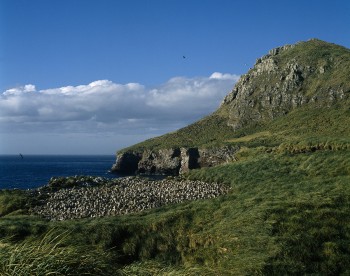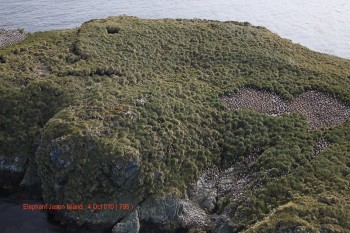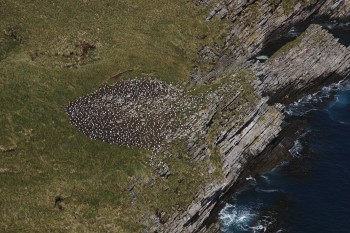Elephant Jason falls within Jason Island Group, part of the Falkland Islands (Islas Malvinas)*, lying north-west of West Falkland. Elephant Jason rises to 208 m and has an area of 260 ha.
The island is government-owned and is a National Nature Reserve designated in 1973. It forms part of the Jason Islands Group Important Bird Area. There is currently no management plan for the island.

Elephant Jason Island showing the main part of the island from its southern end
The island has two small colonies of Black-browed Albatrosses Thalassarche melanophris mixed with Southern Rockhopper Penguins Eudyptes chrysocome. Tussac Grass Poa flabellata surrounds this colony. The albatross is the only ACAP-listed species that breeds on the island.

One of the two albatross colonies with well-grown chicks interspersed with
small numbers of Rockhopper Penguins
In a 2005 aerial survey Elephant Jason was found to support 1302 pairs of breeding Black-browed Albatrosses. In the 2010 survey 1822 pairs were counted, reflecting an increase matched elsewhere within the Falkland Islands (Islas Malvinas)*. However, the Elephant Jason colonies have shown a much slower increase than others in the Jason Island Group. This might be due to the dry nature of the sites restricting the development of new nests. In contrast the nearby South Jason Island colony is one of the fastest growing. The South Jason site is noticeably wet and muddy, being situated in an area of springs.

Aerial photograph of the above colony taken at a height of c. 400 feet (120 m)

A 2010 aerial photograph of the island’s second colony used to mark individual birds
Photographs by Ian Strange
Click here for the ACAP Breeding Sites account for Steeple Jason.
Selected References:
Catry, P., Forcada, J. & Almeida, A. 2011. Demographic parameters of Black-browed Albatrosses Thalassarche melanophris from the Falkland Islands. Polar Biology 34: 1221-1229.
[Falklands Conservation] 2006. Important Bird Areas of the Falkland Islands. London: Falklands Conservation. 160 pp.
Strange, I.J. 2008. Aerial Surveys of Black-browed Albatross Thalassarche melanophris: the Methodology Employed and Comparisons with Surveys Carried out in 1986-2005-2006 and 2007. New Island: Design in Nature & Falkland Islands Wildlife. 59 pp.
Strange, I.J. & Strange, G. 2011. Black-browed Albatross Thalassarche melanophris. Aerial Photographic Survey Methodology: Advantages over Ground Surveying in the Falkland Islands. Results and Comparisons with Surveys in 2005 and 2010. Stanley: Design in Nature. 30 pp.
Wheeler, T. 2004. The Falklands & South Georgia Island. Footscray: Lonely Planet Publications. 200 pp.
Wolfaardt, A.[C.] 2012. An Assessment of the Population Trends and Conservation Status of Black-browed Albatrosses in the Falkland Islands. 23 pp.
Wolfaardt, A.C., Rendell, N. & Brickle, P. 2010. Falkland Islands Implementation Plan for the Agreement on the Conservation of Albatrosses and Petrels (ACAP): Review of Current Work and a Prioritised Work Programme for the Future. Stanley: Falkland Islands Government. 57 pp.
Ian Strange, New Island Conservation Trust, New Island, Falkland Islands (Islas Malvinas)* & John Cooper, ACAP Information Officer, 28 August 2013
*A dispute exists between the Governments of Argentina and the United Kingdom of Great Britain and Northern Ireland concerning sovereignty over the Falkland Islands (Islas Malvinas), South Georgia and the South Sandwich Islands (Islas Georgias del Sur y Islas Sandwich del Sur) and the surrounding maritime areas.

 English
English  Français
Français  Español
Español